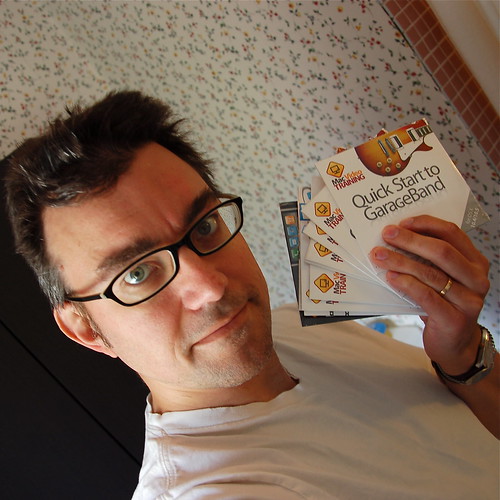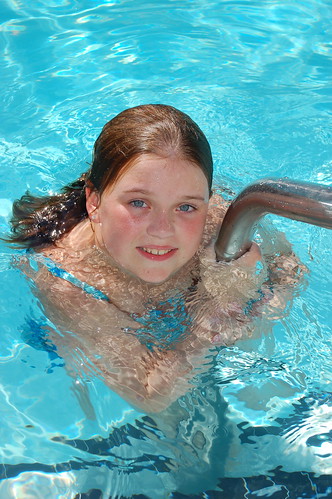Penmachine
31 May 2009
Ignore Oprah's health advice, please
Like most TV shows, The Oprah Winfrey Show is entertaining as its first goal. And like most men, I've rarely enjoyed it much—because it's not aimed at me. That's fine.
But when she discusses health topics, Oprah can be dangerous (here's a single-page version of that long article). You have to infer from her show that on matters of health and medical science, Ms. Winfrey herself doesn't think critically, taking quackery just as seriously as, or more seriously than, anything with real evidence behind it. For every segment from Dr. Oz about eating better and getting more exercise, there seem to be several features on snake oil and magical remedies.
Vaccines supposedly causing autism, strange hormone therapy, offbeat cosmetic surgery, odious mystical crap like The Secret—she endorses them all. Yet even when the ones she tries herself don't seem to work for her, she doesn't backtrack or correct herself. And, almost pathologically, she remains obsessed with her weight despite all her other accomplishments.
Obviously, anyone who's taking their health advice solely from Oprah Winfrey, or any other entertainment personality, is making a mistake. However, I'd go further than that. Sure, watch Oprah for the personal life stories, the freakish tales, her homey demeanor, the cool-stuff giveaways if you want. But if she's dispensing health advice, ignore what she has to say. The evidence indicates to me that, while she may occasionally be onto something good, chances are she's promoting something ineffective or hazardous instead. Taking her advice is not worth the risk.
Labels: biology, controversy, media, science, television
30 May 2009
Luck and randomness
Randomness works in strange ways, at least as far as our minds are concerned. The stars in the sky are distributed essentially randomly (from our viewpoint), yet we see patterns in them—that's because a random distribution is clumpy, not even.
Since our brains seek patterns, we tend to see patterns in random things, like clouds, stains, or the browned surfaces on pieces of toast.
Now check this out: New Jersey grandmother Patricia Demauro played craps at a casino, and rolled a pair of dice 154 times without ever rolling a seven, over the course of more than four hours. The odds? 1.56 trillion to one against. But it happened.
It wasn't impossible, just supremely improbable. Yup, that's random.
Labels: americas, games, probability, psychology
28 May 2009
One weird-ass ship
 At first, you might think a cruise ship collided with an oil rig and then crashed into part of a highway overpass, but no, it's just the M/V Chikyu (via the Maritime Blog). Here's how the BBC describes it:
At first, you might think a cruise ship collided with an oil rig and then crashed into part of a highway overpass, but no, it's just the M/V Chikyu (via the Maritime Blog). Here's how the BBC describes it:
The idea was simple. Scientists wanted to drill down into the Earth's crust—and even through the crust—to get samples from the key zones 6 or 7 km down where earthquakes and lots of other interesting geological processes begin; but that was impossible with existing ships.
Solution: find six hundred million dollars, and design and build a new one.
The Chikyu was built in Japan, is 210 m long (almost 690 feet, as long as a decent-sized cruise ship), and 130 m from the keel to the top of the drilling rig (about 425 feet, taller than a Saturn V rocket floating upright in the ocean). It has a crew of 150.
The crazy structure on the front is a helicopter landing pad. During construction, the ship was nicknamed "Godzilla-maru." And you know, $600 million is a lot of money, but it's not outrageous considering what this vessel does. It's the same price as only two or three 747 jets, for instance.
Labels: geekery, japan, oceans, science, transportation
27 May 2009
Learn GarageBand from me on DVD
My Quick Start to GarageBand video course from MacVideoTraining (a company co-founded by my former podcasting partner Paul Garay) is now available on DVD:
You can get it at London Drugs and many other retailers in North America, or if you use the promo code ihr, you can get a 20% discount if you buy a DVD or download online. The discount code also works for John Biehler's iTunes course and other stuff from MacVideoTraining, including bundles.
Labels: apple, education, insidehomerecording, itunes, paulgaray, recording, software, video
26 May 2009
Seventh time's the charm
Photography website The Luminous Landscape has a fascinating, short essay on how photographer Art Wolfe went through a series of attempts (all shown) to get what turned out to be a great photo.
Aside from his attempts at different composition and lighting, perhaps what's most interesting is that Wolfe took enough pictures for his fisherman subjects to get bored. By the end they were no longer posing, just going on with their work, and that's when the best photo happened. The lesson: keep trying.
Labels: art, photography
An extroverted introvert
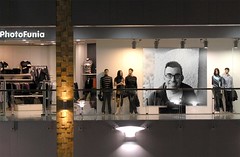 People are supposed to be either introverted or extroverted, but I've never been sure where I fit. Perhaps I'm an ambivert (yuck, an ugly word):
People are supposed to be either introverted or extroverted, but I've never been sure where I fit. Perhaps I'm an ambivert (yuck, an ugly word):
- Most of the time, I like meeting new people; I have stage love instead of stage fright (hence why I've taught courses, given speeches and been in a band for so long); I'm decent with small talk at a party or in a crowd; and I can be quite a chatterbox—not to mention loud—in the right context.
- On the other hand, I always enjoyed being an only child; when I'm uncomfortable or in pain I tend to become quiet and withdrawn; I despise making unsolicited phone calls and am not fond of telephone conversation in general; when out and about (either in my own city or somewhere else) I'm far more likely to wander about alone, take pictures, and think to myself than to strike up conversations with strangers; and I need significant time alone every day, time I often take when the rest of my family is asleep.
So I found Sophia Dembling's "Confessions of an Introverted Traveler" (via Kottke) fascinating. I like her thesis:
Though I don’t need to talk to a lot of people, I love watching them. [...] I travel for the travel.
I suspect I may be primarily an introvert—like Dembling, I find the North American preference for extroversion a bit oppressive. That doesn't mean I prefer solitude in all circumstances, but that social interactions take energy for me, and I need time alone to recharge. I like activities with friends, and especially with my wife and children, but given time to myself, I'm unlikely to want to meet anyone for lunch or a night out. Instead, I might go out by myself, and it doesn't feel at all lonely.
I recall last year's Gnomedex conference in Seattle, an intense three-day geekfest of ideas and discussion together with hundreds of my peers in a Seattle meeting room. The hotel my wife and I chose was a good 20-minute walk away up the waterfront escarpment and through downtown. Despite the physical difficulty of making the trek with my rolling bag of computer and camera gear while suffering cancer-treatment side effects (as I still do), I enjoyed the trip each day. That's because I could be alone and enjoy people-watching as I trundled through the glass tower canyons and Pike Place Market, and either charge up on the way to the meeting, or get my energy back on the way to the hotel.
Right now is a good example too. I've had a rough couple of nights of side effects this week, and my wife is out for the afternoon, but now that I'm finally feeling good, rather than setting up a lunch meeting, or saying hi to my parents (who live next door), I'll probably just go for a solitary walk. That's just what I need.
Labels: cancer, chemotherapy, family, friends, psychology, travel
23 May 2009
Ida the fossil primate isn't a missing link, but she's become a PR stunt
 If you watched the news or read the paper last week, or surfed around the Web, you probably came across one or two or ten breathless news stories about Darwinius masillae (nicknamed "Ida"), a 47 million-year-old fossil primate that was described, over and over again, as a "missing link" in human evolution. It even showed up in the ever-changing Google home page graphic.
If you watched the news or read the paper last week, or surfed around the Web, you probably came across one or two or ten breathless news stories about Darwinius masillae (nicknamed "Ida"), a 47 million-year-old fossil primate that was described, over and over again, as a "missing link" in human evolution. It even showed up in the ever-changing Google home page graphic.
But something in the coverage—many things, really—set off my bullshit detectors. That's because, in years of watching science news, and getting a biology degree, I've learned that the sudden appearance of a story like this (whether a medical miracle cure, a high-energy physics experiment, or a paleontological discovery) indicates that something else is pushing the hype. Most often, there's solid science in there, but the meaning of the study is probably being overplayed, obscured, or misrepresented. And sure enough, that's the case here:
- First of all, it is a wonderful fossil. A very old, essentially complete preserved skeleton and body impression of a juvenile lemur-like primate, which may or may not actually belong to the group of primates that later would include hominids, like us humans. That is super-cool. The fossil also apparently has an interesting history: it was first found over 25 years ago, and kicked around various private collections and museums in more than one piece until quite recently. Only in the past year has it been fully reassembled and analyzed, with the results published this week. That's news.
But, but, but, BUT...
- Darwinius obviously name-checks Charles Darwin. That's grandiose to start with: scientists naming a fossil after Darwin obviously think it's pretty important, and are hyping it up even before anyone else has a chance to evaluate that claim. Yet for precisely that reason, the name feels like a PR stunt to me. Actually, it makes me think of the Disney division that calls its toys Baby Einstein.
- The whole "missing link" business is a crock, whether the publishing scientists actually claim it or not. Evolutionary biology is 150 years old this year—old enough that there aren't any missing links. What I mean is, sure, scientists find new links in the relationships between living organisms all the time. They've been doing that since before Darwin and Wallace first figured out the mechanisms of natural selection.
But the term missing implies that we're still waiting for evidence that organisms evolve, that science still needs something convincing—when we've had overwhelming evidence since Darwin's Origin of Species in 1859 (and before!), while more keeps accumulating all the time. Even aside from all that, there's no indication that Darwinius is a human ancestor. It may be a link to something, and from something, but it's probably not a link from even older primates to us, which is what the news reports are saying. - The first paper about a fossil touted as such a very important, even revolutionary discovery should appear in one of the major global journals, such as Science or Nature, or maybe the Journal of Paleontology or another high-profile publication in the field. Instead, Darwinius is first appearing in PLoS ONE, an interesting but somewhat experimental online journal from the excellent Public Library of Science.
I'm not knocking it, because PLoS ONE is legitimate, and peer-reviewed—indeed, it's doing what many scientists have argued for since the dawn of the Web in the '90s, which is make quality original scientific research available online without the insane subscription fees of traditional journals. But it's also less than three years old. If the Darwinius paper were otherwise unimpeachable, publishing it in PLoS ONE would be a great example of bringing important, leading-edge science into the 21st century of publishing. However, it felt to me instead that it appeared there because it was a fast way to get the paper out for a looming deadline. - Ah, the press conference. It's always suspicious when a scientific discovery is announced at a press conference. When the media event happens simultaneously with, or even before, publication of the formal paper. When experienced science journalists and fellow researchers get no chance to dig into the details before the story goes live to the wires. When there's obviously some other motive keeping the research secret until the Big Reveal.
And that's what it comes down to. It turns out that the U.S. History Channel paid what is surely a lot of money for exclusive access to the research team for a couple of years now, and that the TV special about Darwinius premieres this coming week. What's it called?
Yup, it's called The Link:
Missing link found! An incredible 95 percent complete fossil of a 47-million-year-old human ancestor has been discovered and, after two years of secret study, an international team of scientists has revealed it to the world. The fossil’s remarkable state of preservation allows an unprecedented glimpse into early human evolution.
That entire summary paragraph is crazy hyperbole, or, to put it bluntly, mostly wrong. By contrast, here's what the authors say in their conclusion to the paper itself:
We do not interpret Darwinius as anthropoid, but the adapoid primates it represents deserve more careful comparison with higher primates than they have received in the past.
Translated, that sentence means "we're not saying this fossil belongs to the big group of Old World primates that includes humans, but it's worth looking to see if the group it does belong to might be more closely related to other such primates than everyone previously thought." It's a good, and typically highly qualified, scientific statement. Yet the History Channel page takes the researchers' conclusion (not a human ancestor) and completely mangles it to claim the very opposite (yes a human ancestor)!
It seems that what happened here is that the research team, while (initially at least) working hard to produce a decent paper about an amazing and justifiably important fossil, got sucked into a TV production, rushed their publication to meet a deadline a week before the show is to air, and then let themselves get swept into a media frenzy that has seriously distorted, misrepresented, and even lied about what the fossil really means.
In short, a cool fossil find has turned into a PR stunt for an educationally questionable cable TV special.
Labels: controversy, evolution, linkbait, science, television
20 May 2009
Ouch
 Okay, maybe we did pay a price for our fabulous little trip. Not because of all the heavy food, but from the intensity of the activity. Aside from our outings, we also did a bit of shopping and quite a lot of swimming in the hotel pool. So, after all that, once we got home, my cancer medication side effects kicked in and I was in the bathroom till 2 a.m.
Okay, maybe we did pay a price for our fabulous little trip. Not because of all the heavy food, but from the intensity of the activity. Aside from our outings, we also did a bit of shopping and quite a lot of swimming in the hotel pool. So, after all that, once we got home, my cancer medication side effects kicked in and I was in the bathroom till 2 a.m.
Then, this morning, we were all so wiped out we could hardly struggle out of bed. The kids were tired enough that I kept them home from school so they're in better shape for Thursday (or maybe after lunch today), and I've been resting. Alas, my wife had to make her way to a couple of medical and dental appointments, so she dragged herself out of the house.
Anyway, I think the weekend was enough of an educational experience that it's okay for the girls to miss a bit of school. The Woodland Park Zoo and the Boeing factory are a killer field trip, right?
Labels: cancer, chemotherapy, family, school, seattle, travel
19 May 2009
Airliners are modern miracles of science and engineering
 We've just returned from a whirlwind trip. My daughters had an extra day off school, a professional day following the Victoria Day long weekend, so we made quick plans to stay in a hotel in the Seattle suburb of Lynnwood, Washington, a couple of hours' drive south of here. But to thread the needle of long weekend border traffic, we crossed our station wagon into the USA on Sunday and returned Tuesday.
We've just returned from a whirlwind trip. My daughters had an extra day off school, a professional day following the Victoria Day long weekend, so we made quick plans to stay in a hotel in the Seattle suburb of Lynnwood, Washington, a couple of hours' drive south of here. But to thread the needle of long weekend border traffic, we crossed our station wagon into the USA on Sunday and returned Tuesday.
I'm not quite sure how we fit all we did into the 54 hours we were away, but it included a number of family firsts. My older daughter is a big fan of shrimp, and has been enticed by endless ads for the Red Lobster chain of restaurants. We have none in Vancouver, so Lynnwood offered the closest location, and despite lingering memories of a 1995 food poisoning incident at a California location on our honeymoon, my wife and I agreed to go. We all enjoyed our meals there Sunday night, without later illness.
That was the least of the newness, though. My wife Air and I have traveled to Greater Seattle many times over the years, separately during our childhoods and together since we started dating, both with our kids and without, for fun and on business, as a destination and on the way elsewhere. Yet somehow neither of us had ever visited the wonderful Woodland Park Zoo, or Lynnwood's famous Olympus Spa, or Boeing's widebody jet factory in Everett. This trip we covered them all: the kids and I hit the zoo, Air visited the spa, and all four of us took the Boeing tour today on the way home.
The zoo impressed me, especially the habitats for the elephants, gorillas, and orangutans, but while it was a much shorter activity, the Boeing tour was something else. If you live in this part of the world (Vancouver, Seattle, Portland, and environs), and you're a geek who likes any sort of complicated technology, or air travel, or simply huge-ass stuff, you must go, especially considering there's nowhere else in the world you can easily see something similar. The Airbus factory in France requires pre-registration months in advance, with all sorts of forms filled out and approvals and so forth. We just drove up to Everett, paid a few bucks each, and half an hour later were on our way in.
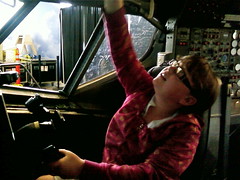 Unfortunately, you're prohibited from taking cameras, electronics, food, or even any sort of bag or purse beyond the Future of Flight exhibit hall where the tour begins, so I have no photos of the assembly plant itself. Trust me, though, it is an extraordinary place. A tour bus drove our group the short distance to the structure, which is the most voluminous building in the world. (Our guide told us all of Disneyland would fit inside, with room for parking. Since the plant is over 3,000 feet long, I figured out that the Burj Dubai tower, the world's tallest building, could also lay down comfortably on the factory's floor space.)
Unfortunately, you're prohibited from taking cameras, electronics, food, or even any sort of bag or purse beyond the Future of Flight exhibit hall where the tour begins, so I have no photos of the assembly plant itself. Trust me, though, it is an extraordinary place. A tour bus drove our group the short distance to the structure, which is the most voluminous building in the world. (Our guide told us all of Disneyland would fit inside, with room for parking. Since the plant is over 3,000 feet long, I figured out that the Burj Dubai tower, the world's tallest building, could also lay down comfortably on the factory's floor space.)
From two separate third-level vantage points inside, accessed by walking down immensely long underground tunnels, then taking freight elevators up into the factory's rafters, we saw more than a dozen of the world's largest aircraft in various stages of assembly. They included several units of the venerable and massive Boeing 747 (its still-revolutionary design is older than me); a couple of nearly complete 767s; a string of 777s in their slow-crawling, constantly-moving U-shaped assembly line; and finally a trio of 787s—a design so new that they are built mostly of composite materials instead of metal, and not even one has yet entered commercial service.
The end of the tour took us outside again on the bus, past the painting hangars and numerous planes waiting for pickup by airlines, as well as one of Boeing's three Dreamlifter cargo monsters, created by cutting off most of the upper half of an old 747 and installing a huge new fuselage top, purely to bring in assembled parts for the new 787s, to be fitted together inside the factory.
While that facility is one structure, which has been expanded over time, each type of plane built there demonstrates how aircraft construction, and industrial assembly lines in general, have changed in the past 40 years. 747s are still built at numerous discrete stations, as they were when the Everett plant first opened in the 1960s. As I mentioned, 777s come together in a single, steady-moving U-shaped line, apparently inspired by the envied Toyota Production System, each plane edging forward steadily at 1.6 inches per hour.
Finally, the new 787 comes together in a short, simple line across the width of the building. That's because (as with competitor Airbus's planes) sections of each aircraft arrive nearly complete from other factories around the world on the Dreamlifter cargo carriers, and are put together in Everett, rather than built from scratch.
I came away newly inspired by the modern miracle of science and engineering that is a jet airliner. These machines are what enable us to complain about waiting around in airports for a few hours, and about substandard in-flight food as we fly between continents—while forgetting that not many lifetimes ago, and for all of human history beforehand, similar voyages might take have taken us years instead of hours, facing danger and starvation and death, if they were possible at all.
Then, on the way home, we bought a bunch of squeeze cheese, also unavailable here in Canada.
Labels: airport, americas, animals, family, geekery, science, seattle, transportation, travel
18 May 2009
Boom
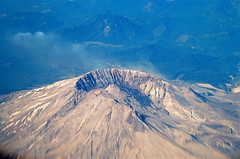 On the morning of May 18, 1980, exactly 29 years ago, I was camping with my Boy Scout troop at Furry Creek, north of Vancouver on the shore of Howe Sound. (The location is now part of a large golf course development, but at the time was essentially just forest near the highway.)
On the morning of May 18, 1980, exactly 29 years ago, I was camping with my Boy Scout troop at Furry Creek, north of Vancouver on the shore of Howe Sound. (The location is now part of a large golf course development, but at the time was essentially just forest near the highway.)
We awoke, terrified, to an enormous thundering crash. It was not, as we had thought, a train derailment on the railroad right near our campsite. It was the titanic sound of the eruption of Mount St. Helens—a sound which had arrived after traveling about 300 km northwest from the explosion. Back in Vancouver, my dad thought our water heater had exploded in the basement.
It was a good reminder that we live in a zone of earthquakes and volcanoes.
Labels: americas, anniversary, history, volcanoes
17 May 2009
Black Destroyer
Enthusiasts agree that science fiction's Golden Age began with A.E. van Vogt's short story "Black Destroyer," published in July 1939, two months after my father was born. You can read the story online, and you'll recognize a lot in it.
So many SF stories have followed in its tradition, but few have done the most interesting thing van Vogt tried: he got inside the head of the lone alien monster, and told most of the tale from its point of view. The atomic power in the story seems a bit hackneyed now—but recall, it was 1939, six years before the Manhattan Project.
Van Vogt, a Canadian, lived a long time, and he saw real voyages through the solar system. He died on January 26, 2000, coincidentally the same day my younger daughter was born. And "Black Destroyer" is still one of the coolest SF short story titles I can think of.
Labels: geekery, history, science, writing
14 May 2009
Choosing enlargements
Last week, for Mother's Day, I had some enlargements made to frame and put on our walls. The London Drugs photo lab did a great job—certainly better than anything I could have accomplished on a home printer, and on proper Fuji photo paper too. Most are family shots, though I did choose one of my more arty images to turn into a 12x18" print. Here's what we picked:
Some of those photos are digital, some film, some colour, some black-and-white. I don't think I would have so many favourite images to pick from, and be able to have them printed and framed so inexpensively, in any photographic age except this one.
Yet, in another way, they could have been taken almost anytime. Closeups of young faces, kids laughing on a snowy slope or a sandy beach, a fishing boat and distant volcano—all could have been 20 or 40 or 60 or 80 years ago, and much the same. I guess that's one reason I like them.
Labels: family, home, photography
13 May 2009
B.C. voters prefer the lame status quo
The BC Liberals won the British Columbia election again last night, as I expected. B.C. citizens gave them basically the same proportion of the vote and a slightly larger percentage of seats in the Legislature. Much more depressingly, voter turnout was yet again lower and BC-STV was resoundingly defeated. That's over. We're back with what we had before.
The BC Liberals are not my preferred choice, but they are at least tolerably competent in many respects. I guess I can live with that. However, the STV referendum gave us the chance to make our provincial government more representative and more interesting in the future, and we British Columbians turned it down.
My gut reaction is that yesterday, we B.C. voters were, on balance, lazy and chickenshit. That half of eligible voters didn't even bother, and that of those who did, a significant majority thought our current skewed system is just fine—well, that chafes.
I don't know if the numbers bear it out, but to me it feels like more people cared about how the Canucks did in the hockey playoffs than about deciding on the people we pay to respond to climate change, or to combat poverty, or to run the bloody province. And that we'll will bitch and complain about roads or homelessness or white-elephant megaprojects or the Olympics or cronyism and then not even vote when we get the chance.
On the bright side, perhaps the Liberals will be emboldened by a third straight victory to go beyond baby steps in their environmental policy. Maybe they can take a real lead in Canada on that most important of issues. They have a mandate to. I'm not optimistic, but I hope they run with it.
Labels: canada, environment, history, politics
12 May 2009
Today's vote
We're having a provincial election in British Columbia today, to decide which of our political parties will form the government for the next few years here on Canada's west coast. As in the British and Canadian federal parliamentary systems, we elect a local Member of the Legislative Assembly (MLA), and whichever party elects the most runs the province.
Tim Bray summarizes the situation much the way I would—however, despite my distaste for the social democrat NDP's pandering on environmental policy, I'm still voting for them, rather than for the Greens as Tim is.
That's a strategic choice. Like him, I think the referendum on electoral reform we're also holding today is even more important: the BC-STV (Single Transferable Vote) proposal is, I think, a good one, and would allow a vote for the Green Party (or other less mainstream parties and candidates) to mean something in subsequent elections. I hope it passes, as it nearly did in 2005. If it fails, I think any idea of electoral system reform in Canada will be dead for a long, long time, which would be a shame.
My wife and I voted about half an hour ago, and foot traffic at our local poll was brisk, but there were no lineups. Unlike in the United States, we continue to use simple paper ballots, marked with pencils, for all our elections here in Canada, and the results always come in quickly and efficiently. While counting might take a tad longer, that will still be true next election if BC-STV passes, despite the "it's too complicated" tactics of the No To STV campaign. As for today's vote, we'll know by late this evening what the results are.
If you're a B.C. citizen of eligible age, please make sure you vote today—you have a little over five hours until the 8 p.m. closing time at the polls. (Bring your yellow voter card and a piece of ID with your address, like a driver's license.) Even if you don't know or care enough about the parties or candidates to elect an MLA, if you support BC-STV, then please go out and vote just for that. It's important.
Labels: canada, history, politics
09 May 2009
Redeeming the prequel
 Remember back in 2006 when I raved about the then-new Casino Royale? It defined how to reboot a movie franchise. And the new Star Trek, which I saw tonight, learned that James Bond lesson, in spades.
Remember back in 2006 when I raved about the then-new Casino Royale? It defined how to reboot a movie franchise. And the new Star Trek, which I saw tonight, learned that James Bond lesson, in spades.
Trek never shied away from time travel—the old crew used it to do everything from keeping the Nazis from winning the War to saving the whales (and the Earth). But the new movie is especially clever with it, managing to maintain the integrity of the original series and movies, and all their sequels, while giving the "new" crew entirely different directions to go.
In another way, that hardly matters. My kids enjoyed the movie tremendously, even though they know basically nothing about previous Treks. It's just a great big ball of fun. Despite all the praise it's received, it was also still considerably better than I expected.
But that was Winona Ryder? Didn't even recognize her.
Labels: film, movie, review, startrek
07 May 2009
The Kindle DX is getting there
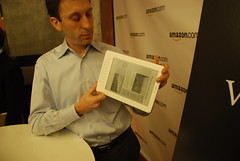 I have to say, Amazon's newly-announced Kindle DX, with a much larger screen than the original Kindle, is looking pretty good as an e-book reader. It's bigger, has more storage, and reads PDFs natively without conversion.
I have to say, Amazon's newly-announced Kindle DX, with a much larger screen than the original Kindle, is looking pretty good as an e-book reader. It's bigger, has more storage, and reads PDFs natively without conversion.
Too bad that, like its predecessor, it's unavailable in Canada (or anywhere outside the U.S.). It remains a bit of a polarizing device, but Amazon obviously believes this is where things are going. They're one of the only companies that might make it happen—if they're right about e-books being the future.
The DX is pricey, at almost $500 USD, and its e-ink technology is still a bit immature. However, maybe in a few years we'll be reading those Stanley Kubrick–style book pads after all, only a decade or so late.
05 May 2009
Flutebox and Beardyman
[Cross-posted from Inside Home Recording (IHR).]
We've highlighted some fine beatboxers at IHR over the years, but these two (Flutebox and Beardyman, from the U.K.) are the best I've ever seen:
There's so little technology here (two mics, two voices, and a flute), such a performance could theoretically have happened 50 years ago, but no one would have thought of it. Eighteen minutes may seem awfully long for a web video, but I promise you'll be mesmerized. It's worth watching all the way through.
Labels: band, insidehomerecording, music, video, youtube
04 May 2009
Disney's coordinated maw
What's wrong with me? My wife goes out of town on a fun vacation for a few days, and I get all cranky and ranty on this blog. (Fortunately, only here, not with the kids or anyone else.) First it's asbestos, then knowledge vs. understanding, then child safety.
Today? Well, via Kottke, it's something big: the Jonas Brothers. Even my daughters, in the prime Jonas target demographic at ages 9 and 11, hate them. Because, as musically inclined children, my kids told me without any prompting that the Jonases can't sing or write a decent tune. But it's worse than that:
Teenage life is sexual emergence and rock music often times is sex. The problem is that The Jonas Brothers conceal sexuality under the guise of sex-free fun.
My daughters aren't yet teens, but they can already sense something fundamentally false about the Jonas Brothers' "rock and roll purity." My girls do enjoy Miley Cyrus, who may be part of the same Disney machine, but at least she can sing (despite all the Auto-Tune processing on her recordings), she's shown hints of creating an interesting career for herself in the future, and her sitcom is pretty funny. Yet they've also noticed the seemingly endless succession of new "stars" coming out of Disney's coordinated maw at the moment.
They still prefer The Beatles to any of the others, anyway. Now there's a boy band we can believe in, and sexy too.
03 May 2009
Children are safe, and should be outside
 Lenore Skenazy's Free-Range Kids sounds like a fascinating book (she has an accompanying blog too). Her argument, essentially, is that the crime rate today is equal to what it was back in 1970, and kids should go outside alone, as they always did in human history. "If you try to prevent every possible danger or difficulty in your child's everyday life," she says, "that child never gets a chance to grow up."
Lenore Skenazy's Free-Range Kids sounds like a fascinating book (she has an accompanying blog too). Her argument, essentially, is that the crime rate today is equal to what it was back in 1970, and kids should go outside alone, as they always did in human history. "If you try to prevent every possible danger or difficulty in your child's everyday life," she says, "that child never gets a chance to grow up."
Our daughters have been walking to school by themselves for awhile now, but they're not wandering the neighbourhood all day as I used to 30 years ago. They probably should, but I don't think the idea has even occurred to them. That despite the likelihood that today's environment has probably made our kids safer than any kids have ever been, particularly when you take disease prevention into account.
In Vancouver, though, we can blame this new parental paranoia on Clifford Olson, and it has spread across much of the Western world. I think Skenazy's instinct to let her nine-year-old son explore New York City alone last April—with a transit pass and some quarters for a pay phone if he needed them (he didn't)—is a good one. He wanted to try, and he was ready.
"We become so bent out of shape over something as simple as letting your children out of sight on the playground that it starts seeming on par with letting them play on the railroad tracks at night. In the rain. In dark non-reflective coats," writes Skenazy. "The problem with this everything-is-dangerous outlook is that over-protectiveness is a danger in and of itself. A child who thinks he can't do anything on his own eventually can't."
Our experience bears this out, in an odd way. The only injuries my daughters have ever suffered that required hospital visits happened, (a) stepping out of our bathtub, (b) bouncing on a bed, (c) being rear-ended in a crash in our car, and (d) scraping a chin at a swimming pool. In all cases, we were right there, and we didn't make them any safer. There are dangers in all of our lives, but they're not generally the ones we fear.
Labels: controversy, family, linkbait, news, newyork, probability
02 May 2009
Knowing the reactor
 It's been just over 30 years since the Three Mile Island nuclear power plant had a partial meltdown. In many ways, Three Mile Island marked the end of the age of innocence for nuclear power, with the door slammed seven years later by Chernobyl.
It's been just over 30 years since the Three Mile Island nuclear power plant had a partial meltdown. In many ways, Three Mile Island marked the end of the age of innocence for nuclear power, with the door slammed seven years later by Chernobyl.
I was nine, but tech columnist Bob Cringely was there. He says the accident happened because:
[The operators' job] was to follow the manual. All knowledge was inside the book. So knowing the book was everything. Unfortunately knowing the book isn’t the same as knowing the reactor.
How many of us, in the things we do, know the book but don't know the reactor? We know the processes, or the steps, but not the reasons behind them. But knowing how and why something works lets you handle the unexpected.
Labels: controversy, history, science
01 May 2009
Canada's asbestos problem
 Mine is a pretty sensible country, just like our stereotype, but not always. A key example is our bizarre asbestos industry.
Mine is a pretty sensible country, just like our stereotype, but not always. A key example is our bizarre asbestos industry.
Asbestos is nasty shit: "All forms of asbestos," says Leslie Stayner, director of epidemiology and biostatistics at the University of Illinois School of Public Health, "cause both mesothelioma and lung cancer." Anytime asbestos is discovered in old construction here in Canada, the location is shut down for thorough removal of the mineral. Numerous countries around the world have banned use of the substance outright.
Yet in a few Quebec towns, asbestos mining continues, supporting about 500 jobs and bringing in about $100 million a year. (My wife visited one of those towns, Thetford Mines, on a French exchange when she was a kid and the industry was larger.) Since it's illegal to use here, our asbestos gets shipped overseas, to India, Indonesia, Thailand, and elsewhere where it's still permitted. There, it presumably kills people by giving them cancer.
The puzzling thing is that the Canadian government acts like it's still the 1940s, arguing that the form of asbestos we mine and sell, called chrysotile, can be handled and used safely. Perhaps it can, though it seems unlikely—plus I highly doubt construction projects in developing countries do so anyway.
Even our erudite new Leader of the Opposition, Michael Ignatieff, seems to have been cowed by the asbestos lobby, moving from a strong anti-asbestos position a couple of months ago to a "we need more research" stance. Yet we've known for decades that the stuff is a substantial, carcinogenic health hazard in all its forms.
It's sad to say, but if Canada's asbestos industry were anywhere other than Quebec, it probably would have shut down years ago, especially since it is now such a small part of our economy. Continued support from our two major federal parties, the Liberals and the Conservatives, seems to me a cynical political move, to avoid offending Quebec nationalists and the chrysotile lobby based in that province.
So one of our long-simmering domestic political quagmires keeps us selling a toxic mineral to the developing world. Not very sensible.
Labels: canada, cancer, controversy, environment, linkbait, politics
